Stevns Klint is a coastal area in Denmark, located about 70 km south of Copenhagen. Stevns Klint is a white chalk cliff of 15 km in lenght and is a place of extreme geological and scientific value. Stevns Klint bears witness to the impacht of the Chicxulub meteorite who struck the Earth about 66 millions years ago. Researchers are convinced, that this meteorite impact has caused the largest mass extinction in the history of Earth, 50 % of all life on earth disapeared, including the dinosuars. The evidence of this dramatic period in the history of the Earth is hidden in the limestone cliffs and the thin layer of fish clay, the greyish layer is only 5-10 cm thick. Stevns Klint is the best place in the world to study this this clay. In the area around Stevns Klint are found the traces of the ash cloud, created by the impact of the meteorite. The exact impact location of the meteorite was the ocean floor off the coast of the Mexican Yucatán peninsula. Stevns Klint contains an exceptional quantity of fossils, the fossils also show the full recovery of the fauna after the mass extinction. Stevnsfortet is a Cold War fortress constructed in 1952-1954, a large underground labyrinth of tunnels, dug deep into the cliffs of Stevns Klint. Nowadays, it is the Cold War Museum. Some other World Heritage Sites located close to Stevns Klint: the hunting landscape Jægersborg Dyrehave about 79 km to the north; Roskilde Cathedral about 48 km to the northwest; Kronborg Castle about 105 km to the north. Stevns Klint gained status the as a UNESCO World Heritage in 2014. It is a natural UNESCO World Heritage Site.
www.werelderfgoedfotos.nl © Copyright World Heritage Photos
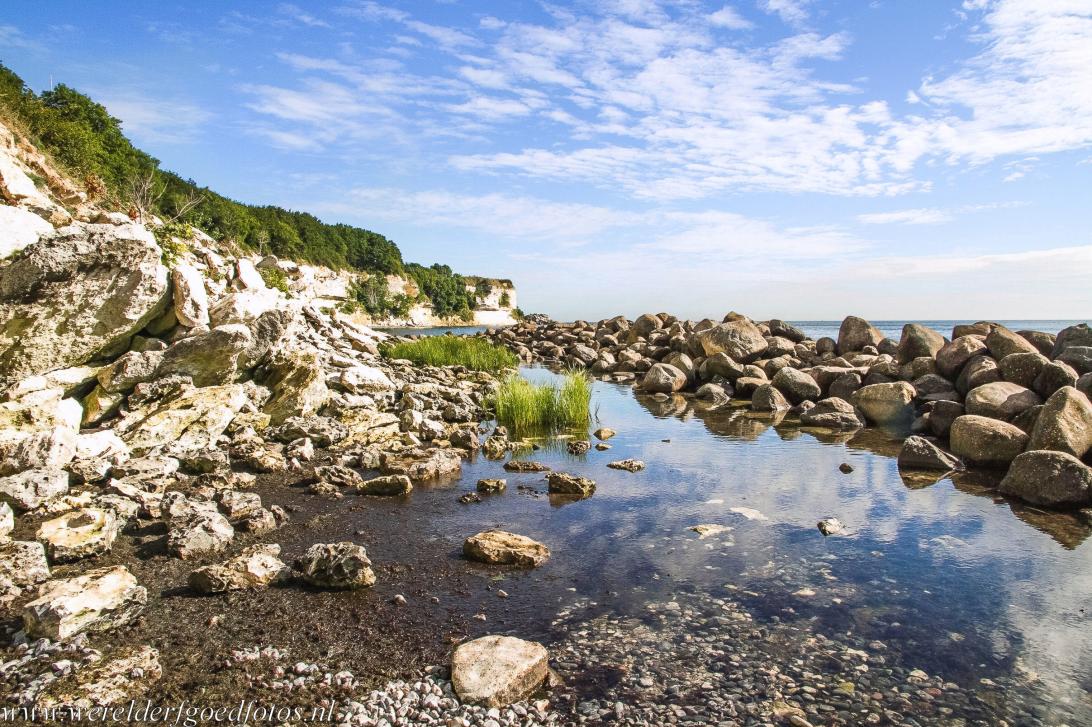
A pebbled beach next to the white cliffs of Stevns Klint. Stevns Klint is situated on the Island of Zealand in Denmark. A thin layer of greyish fish clay is hidden between the thick layers of white chalk and yellow limestone in Stevns Klint. The layer of greyish fish clay is the silent witness to the extinction of the dinosaurs about 66 millions years ago when the huge Chicxulub meteorite hit the Earth. Stevns Klint gained the status the as a UNESCO World Heritage in 2014.

A pebbled beach next to the white cliffs of Stevns Klint. Stevns Klint is situated on the Island of Zealand in Denmark. A thin layer of greyish fish clay is hidden between the thick layers of white chalk and yellow limestone in Stevns Klint. The layer of greyish fish clay is the silent witness to the extinction of the dinosaurs about 66 millions years ago when the huge Chicxulub meteorite hit the Earth. Stevns Klint gained the status the as a UNESCO World Heritage in 2014.
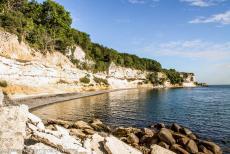
The white cliffs of Stevns Klint are facing the Baltic Sea. A dramatic period in the history of our planet is hidden in the white cliffs of Stevns Klint. The evidence of this period is visible in a thin layer of greyish fish clay, it bears witness to the impacht of the Chicxulub meteorite who struck the Earth about 66 millions years ago, the impact wiped out half of all plant and animal species, amongst them the dinosaurs. The thin layer of fish clay lies almost hidden between thick layers of soft white chalk and yellow limestone, just underneath the overhang.
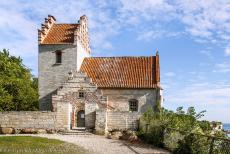
The Old Højerup Church is situated on the edge of the cliffs of Stevns Klint, the balcony of the church offers beautiful views over the Baltic Sea and Stevns Klint. Due to erosion, the choir and a huge part of the graveyard slipped into the Baltic Sea in 1928. The religious services were held until 1910, when the danger of the church crashing into the sea had become serious. Today, the Old Højerup Church is a popular tourist attraction. About 300 metres from the edge of the cliffs the New Højerup Church was built in 1913.
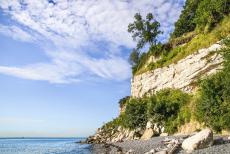
The lower part of Stevns Klint is composed of soft white chalk, the upper part is a hard yellow limestone, right in between those two layers, there is a thin layer of the fish clay, the clay marks the K-T Boundary, the end of the Cretaceous Period and the beginning of the Paleogene Period around 66 millions years ago, when the Chicxulub struck the Earth. The fish clay contains fossil fish remains and iridium, this element is found in meteorites.
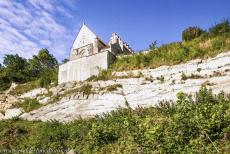
Stevns Klint: The Old Højerup Church on the edge of the cliff viewed from the beach. The church was built from local limestone around 1250, at a safe distance from te sea. In the course of time, the weather and the sea had damaged the cliffs of Stevns Klint, the sea has eaten away the cliffs and on 16 March 1928, the choir of the church slipped into the sea. Fortunately, the church was already closed in 1910 for the fear of a collapse. The remnants of the Old Højerup Church were reinforced against further landslides.
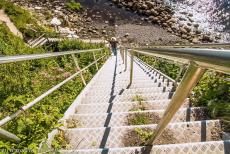
From the top of the white cliffs of Stevns Klint a steep staircase leads down to the beach. In the area around Stevns Klint are found the traces of the enormous ash cloud, created by the impact of the immense Chicxulub meteorite. Stevns Klint contains an exceptional quantity of fossils, the fossils also show the full recovery of the fauna after the mass extinction caused by the impact of the Chicxulub meteorite.
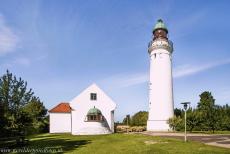
Stevns Klint: Stevns Fyr is the lighthouse close to Store Heddinge. Stevns Lighthouse is situated at the highest point of Stevns Klint, about 41 metres above sea level. In spring and autumn, the area around the lighthouse is a favorite spot to observe migratory birds. Millions of migrating birds pass Stevns Lighthouse each year, including cranes. Stevns Klint stretches from Bøgeskov Havn in the north to Rødvig Havn in the south.
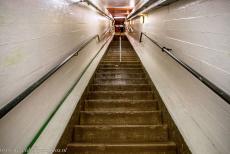
Stevns Klint: The stairs down to the underground Stevnsfort, built beneath the white cliffs of Stevns Klint. Stevnsfort is a network of tunnels, 18 metres below ground surface. Stevnsfort was built in 1952-1954. Stevnsfort was part of the secret defence system of Denmark and the NATO. Nowadays, Stevnsfort is the Koldkrigsmuseum Stevnsfort, the Stevnsfort Cold War Museum. The Stevnsfort Cold War Museum was opened to visitors in 2008.
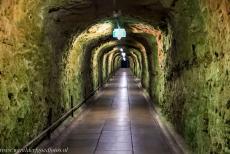
Stevns Klint: Stevnsfort consists of a network of underground passages, dug deep into the chalk cliffs of Stevns Klint. The underground fortress possessed of a command centre, living quarters, ammunition depots, a hospital and a chapel, and also food supplies for several months. During the Cold War, Stevnsfort played an important role in the defence of Denmark and the NATO, the secret underground forresst was part of the front line between East and West.
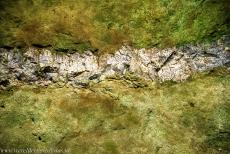
Stevnsfort is now the Koldkrigsmuseum Stevnsfort, the Cold War Museum Stevnsfort, a unique museum to experience the history of the Cold War. Stevnsfort was constructed deep inside the white cliffs of Stevns Klint. The network of underground tunnels is about 1.6 km long. The walls in the underground tunnels of the fortress are covered with moss, the greyish flint bands in the chalk and limestone of Stevns Klint depict the outline of the ancient seafloor.
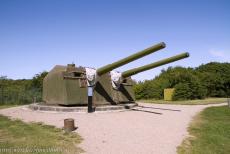
Stevns Klint: The Koldkrigsmuseum Stevnsfort, the Stevnsfort Cold War Museum,at Rødvig, a town on the southern coast of Stevns Klint. The guns from the Gneisenau, a battlecruiser of the Kriegsmarine, the navy of Nazi-Germany. The Gneisenau was decommissioned in 1942, the 15 cm guns were removed and used as coastal batteries on the west coast of Jutland in Denmark. The guns were moved to their current position on Stevnsfort in 1952.
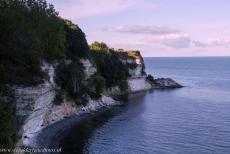
Sunset at Stevns Klint. The Stevns Klint Trampesti is a coastal hiking trail. The route runs from the port town of Rødvig in the south to Bøgeskov Harbour in the north. The trail is about 20 km long and follows the coastline of Stevns Klint. The trail is known for its breathtaking views over the Baltic Sea. The hiking trail runs along the edge of Stevns Klint.
